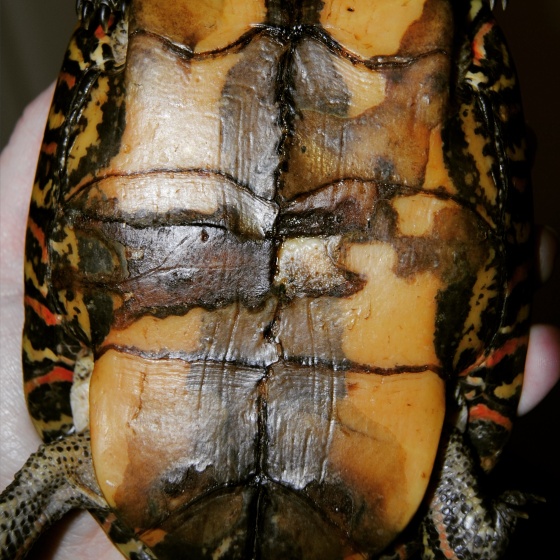Commonly, rot of any kind in myriad reptile species is caused by poor husbandry conditions and the stress that stems from it. Dirty water, dirty cage, poor heating, bad food, etc. The best way to treat scale rot, shell rot, tail rot, or mouth rot is to avoid it altogether.
Obviously, you wouldn’t be reading this article unless that opportunity hadn’t already passed, though.
The good news is that rot, if caught early enough, can be fixed with relative ease. By “ease,” I mean: without a trip to the vet. Now, that’s not to say a vet trip couldn’t be recommended. When in doubt, I would always suggest having the experts take a look at your beloved pet. It’s better to be safe than sorry, right?
Assuming that you feel the rot hasn’t reached the point of necessitating a vet appointment yet, let’s proceed:
Signs of rot –
- Dark coloration on scales (similar in some ways to a bruise)
- Blisters or sores
- Abscesses or lesions
- Dead tissue, loose scutes, or visible infections
Example of rot –

Steps to treat scale, shell, or tail rot –
- Remove any excess skin, scales, or scutes that you can easily remove. Do not pry or force. For turtles, take a soft bristle brush (a toothbrush works well) and clean the infected areas with soap and water. Rinse when done.
- Soak the animal in a Betadine and water solution for approximately 30 minutes. When mixing your Betadine, pour just enough into the water to make the solution look like weak tea. Keep your animal from swallowing the solution. Try, also, to keep their head above water as the Betadine may cause irritation of the eyes or soft tissue in the mouth or nostrils.
- After 30 minutes, remove and dry the animal with a clean towel or clean paper towels. Apply dabs of Neosporin to any infected area. (Note: do not use the Neosporin that offers “pain relief” as this is bad for your reptile; the plain Neosporin is best.)
- Set up a quarantined, sanitary box for your pet with paper towels for bedding and new, clean bowels for water and food. This will be his hospital room for as long as the infection persists. Clean daily to avoid re-infection. Keep the environment dry (the infection thrives in moisture).
- If you have an aquatic animal, give them a few hours to dry out before reintroducing them to a thoroughly cleaned tank.
- Repeat steps daily for one week and every other day for as long as two weeks. If you see no improvement after a month, my suggestion would be to take the animal to the vet.
Mouth rot –
- Unless you have extensive experience with reptiles, I would not advise treating mouth rot yourself. This can potentially injure the animal, make the rot worse, or get you bit!
- If you’re insistent on doing it yourself, pour yourself a small solution of Betadine and water (“weak tea” colored) and, using a Q-tip, carefully clean the infected area daily.
- If you’re savvy enough, you may consider giving an injection of Baytril to clear up the infection. Again, this is not advised. You can mortally wound your pet if it’s done incorrectly.
